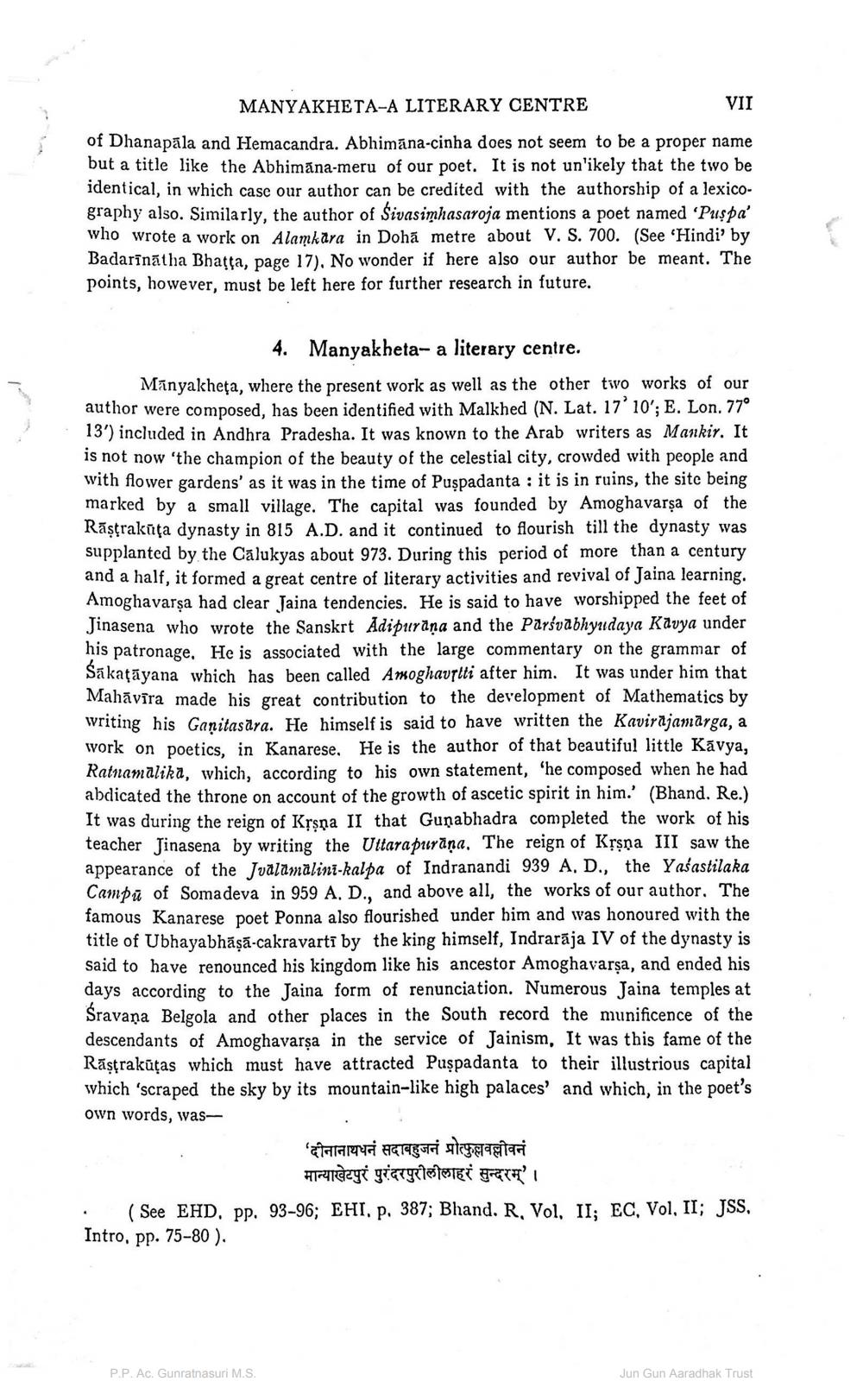________________ MANYAKHETA-A LITERARY CENTRE VII of Dhanapala and Hemacandra. Abhimana-cinha does not seem to be a proper name but a title like the Abhimana-meru of our poet. It is not unlikely that the two be identical, in which case our author can be credited with the authorship of a lexicography also. Similarly, the author of Sivasimhasaroja mentions a poet named 'Puspa' who wrote a work on Alamkara in Doha metre about V. S. 700. (See 'Hindi' by Badarinatha Bhatta, page 17), No wonder if here also our author be meant. The points, however, must be left here for further research in future. 4. Manyakheta- a literary centre. Manyakheta, where the present work as well as the other two works of our author were composed, has been identified with Malkhed (N. Lat. 17' 10'; E. Lon. 77deg 13') included in Andhra Pradesha. It was known to the Arab writers as Mankir. It is not now 'the champion of the beauty of the celestial city, crowded with people and with flower gardens' as it was in the time of Puspadanta : it is in ruins, the site being marked by a small village. The capital was founded by Amoghavarsa of the Rastrakuta dynasty in 815 A.D. and it continued to flourish till the dynasty was supplanted by the Calukyas about 973. During this period of more than a century and a half, it formed a great centre of literary activities and revival of Jaina learning. Amoghavarsa had clear Jaina tendencies. He is said to have worshipped the feet of Jinasena who wrote the Sanskrt Adipurana and the Parsvabhyudaya Kavya under his patronage. He is associated with the large commentary on the grammar of Sakatayana which has been called Amoghavrtti after him. It was under him that Mahavira made his great contribution to the development of Mathematics by writing his Ganitasara. He himself is said to have written the Kavirajamiarga, a work on poetics, in Kanarese. He is the author of that beautiful little Kavya, Ratnamalika, which, according to his own statement, 'he composed when he had abdicated the throne on account of the growth of ascetic spirit in him.' (Bhand. Re.) It was during the reign of Krsna II that Gunabhadra completed the work of his teacher Jinasena by writing the Uttarapuvana. The reign of Krsna III saw the appearance of the Jualamalini-kalpa of Indranandi 939 A, D., the Yasastilaka Campu of Soma deva in 959 A. D., and above all, the works of our author. The famous Kanarese poet Ponna also flourished under him and was honoured with the title of Ubhayabhasa-cakravarti by the king himself, Indraraja IV of the dynasty is said to have renounced his kingdom like his ancestor Amoghavarsa, and ended his days according to the Jaina form of renunciation. Numerous Jaina temples at Sravana Belgola and other places in the South record the munificence of the descendants of Amoghavarsa in the service of Jainism, It was this fame of the Rastrakutas which must have attracted Puspadanta to their illustrious capital which 'scraped the sky by its mountain-like high palaces' and which, in the poet's own words, was 'दीनानाथधनं सदाबहुजनं प्रोत्फुल्लवल्लीवनं मान्याखेटपुरं पुरंदरपुरीलीलाहरं सुन्दरम् / * (See EHD. pp. 93-96; EHI. p. 387; Bhand. R, Vol. II; EC, Vol. II; JSS, Intro, pp. 75-80 ). P.P. Ac. Gunratnasuri M.S. Jun Gun Aaradhak Trust




